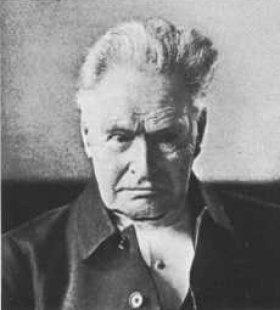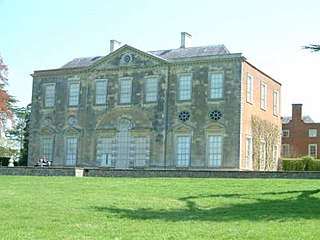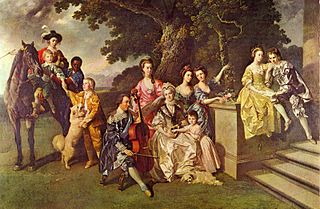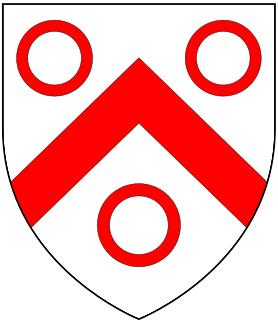Related Research Articles

Viscount Gage, of Castle Island in the County of Kerry of the Kingdom of Ireland, is a title in the Peerage of Ireland. It was created in 1720 for Thomas Gage, along with the subsidiary title of Baron Gage, of Castlebar in the County of Mayo, also in the Peerage of Ireland. In 1744 he also succeeded his cousin as eighth Baronet, of Firle Place. The titles remain united. The Gage family descends from John Gage, who was created a baronet, of Firle Place in the County of Sussex, in the Baronetage of England on 26 March 1622. His great-grandson, the seventh Baronet, represented Seaford in Parliament. He was succeeded by his first cousin, Thomas Gage, 1st Viscount Gage, the eighth Baronet. He sat as a Member of Parliament for Minehead and Tewkesbury and also served as Governor of Barbados. In 1720, 24 years before succeeding in the baronetcy, he was raised to the Peerage of Ireland as Baron Gage and Viscount Gage. His second son was the military commander the Hon. Thomas Gage.

Viscount Scarsdale, of Scarsdale in Derbyshire, is a title in the Peerage of the United Kingdom. It was created in 1911 for the prominent Conservative politician and former Viceroy of India George Curzon, 1st Baron Curzon of Kedleston, who was created Earl Curzon of Kedleston at the same time and was later made Marquess Curzon of Kedleston.

Baron Bagot, of Bagot's Bromley in the County of Stafford, is a title in the Peerage of Great Britain. It was created on 12 October 1780 for Sir William Bagot, 6th Baronet.

Lord Aylmer, Baron of Balrath, in the County of Meath, is a title in the Peerage of Ireland. It was created in 1718 for the naval commander Matthew Aylmer, the second son of Sir Christopher Aylmer, 1st Baronet, of Balrath. Lord Aylmer's son, the second Baron, represented Rye in the House of Commons. The latter's grandson, the fourth Baron, succeeded his kinsman as seventh Baronet, of Balrath, in 1776. The titles remain united. He was succeeded in both titles by his son, the fifth Baron. He was a general in the Army and served as Governor General of Canada from 1830 to 1835. Lord Aylmer assumed by Royal licence the additional surname of Whitworth in 1825 on the death of his uncle Charles Whitworth, 1st Earl Whitworth. On his death the titles passed to his younger brother, the sixth Baron. He was an admiral in the Royal Navy.

Baron Grimthorpe, of Grimthorpe in the East Riding of the County of York, is a title in the Peerage of the United Kingdom. It was created on 17 February 1886 for the lawyer and architect Edmund Beckett, 1st Baron Grimthorpe, 5th Baronet, with remainder to the heirs male of his father. He was succeeded according to the special remainder by his nephew, the second Baron. He had earlier represented Grimsby in Parliament. As of 2014 the titles are held by the latter's great-grandson, the fifth Baron, who succeeded his father in 2003.
Baron Moncreiff, of Tulliebole in the County of Kinross, is a title in the Peerage of the United Kingdom. It was created on 9 January 1874 for the lawyer and Liberal politician Sir James Moncreiff, 1st Baronet. He had already been created a Baronet, of Kilduff in the County of Kinross, in the Baronetage of the United Kingdom on 23 May 1871. In 1883 Lord Moncreiff also succeeded his elder brother as 11th Baronet, of Moncreiff in the County of Perth. On his death the titles passed to his eldest son, the second Baron. He was a Judge of the Court of Session from 1888 to 1905 under the title of Lord Wellwood and served as Lord Lieutenant of Kinross-shire between 1901 and 1909. He was succeeded by his younger brother, the third Baron. He was a clergyman. As of 2010 the titles are held by the latter's great-grandson, the sixth Baron, who succeeded his father in 2002.

Baron Burnham, of Hall Barn in the Parish of Beaconsfield in the County of Buckingham, is a title in the Peerage of the United Kingdom. It was created on 31 July 1903 for the influential newspaper magnate Sir Edward Levy-Lawson, 1st Baronet, owner of The Daily Telegraph. He had already been created a Baronet, of Hall Barn in The Parish of Beaconsfield in the County of Buckingham and of Peterborough Court in the City of London, in the Baronetage of the United Kingdom on 13 October 1892. Levy-Lawson was the son of Joseph Moses Levy, who acquired The Daily Telegraph only months after its founding.

There have been three baronetcies created for persons with the surname Croft, one in the Baronetage of England and two in the Baronetage of the United Kingdom. All three creations are extant as of 2008.

There have been two baronetcies created for members of the Hanmer family of Flintshire, Wales, one in the Baronetage of England and one in the Baronetage of Great Britain. Only one creation is extant as of 2008. The third Baronet of the second creation was elevated to the peerage as Baron Hanmer in 1872, a title which became extinct in 1881. The family name derived from the manor of Hanmer in the Diocese of St. Asaph.

There have been three baronetcies created for persons with the surname Holden, all in the Baronetage of the United Kingdom. Two of the creations are extant as of 2010.

There have been three baronetcies created for persons with the surname Verney, one in the Baronetage of England and two in the Baronetage of the United Kingdom. Two of the creations are extant as of 2016.

There have been five baronetcies created for persons with the surname Young, one in the Baronetage of England, one in the Baronetage of Great Britain and three in the Baronetage of the United Kingdom. As of 2014, four of the creations are extant.
There have been seven baronetcies created for persons with the surname Thompson, one in the Baronetage of England, one in the Baronetage of Great Britain and five in the Baronetage of the United Kingdom. Three of the creations are extinct while four are extant. See also Thomson baronets and Meysey-Thompson baronets.

There have been four baronetcies created for persons with the surname Hope, three in the Baronetage of Nova Scotia and one in the Baronetage of the United Kingdom. As of 2010 one creation is extant, one dormant and two extinct.

There have been four baronetcies created for persons with the surname Miller, two in the Baronetage of England, one in the Baronetage of Great Britain and one in the Baronetage of the United Kingdom. Two of the creations are extant as of 2008.

The Trelawny, later Salusbury-Trelawny Baronetcy, of Trelawny in the County of Cornwall, is a title in the Baronetage of England. It was created on 1 July 1628 for John Trelawny of Trelawny in the parish of Pelynt in Cornwall. The family derived much of their political power from their patronage of the nearby pocket borough of East Looe. The second Baronet sat as Member of Parliament for East Looe, Cornwall and Liskeard. The third Baronet was a clergyman and one of the Seven Bishops imprisoned by James II. The fourth Baronet represented West Looe, Liskeard and East Looe in the House of Commons. The fifth Baronet was Member of Parliament for East Looe. The sixth Baronet sat as Member of Parliament for West Looe and served as Governor of Jamaica. The eighth Baronet was Member of Parliament for East Cornwall 1832–1837 and Lord-Lieutenant of Cornwall. In 1802 he assumed the additional surname of Salusbury. The ninth Baronet represented Tavistock and East Cornwall in Parliament.

There have been seventeen baronetcies for persons with the surname Stewart, ten in the Baronetage of Nova Scotia, one in the Baronetage of Ireland and six in the Baronetage of the United Kingdom. See also Steuart baronets, Henderson-Stewart baronets, MacTaggart-Stewart baronets and Stewart-Clark baronets.
There have been eight baronetcies created for persons with the surname Graham, two in the Baronetage of Nova Scotia, two in the Baronetage of England, one in the Baronetage of Great Britain and three in the Baronetage of the United Kingdom.
There have been eight baronetcies created for persons with the surname Jackson, one in the Baronetage of England, one in the Baronetage of Great Britain and six in the Baronetage of the United Kingdom. As of 2014 four of the creations are extant.

There have been two baronetcies created for persons with the surname Goring, both in the Baronetage of England. The second creation came into the family through a special remainder in the patent creating the baronetcy. Only the latter creation is extant as of 2008.
References
- Kidd, Charles, Williamson, David (editors). Debrett's Peerage and Baronetage (1990 edition). New York: St Martin's Press, 1990, [ page needed ]
- Leigh Rayment's list of baronets